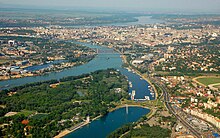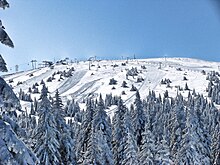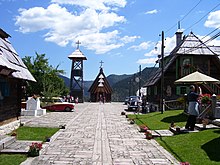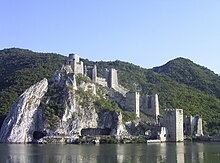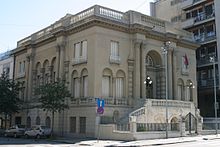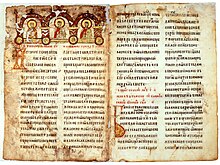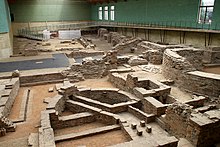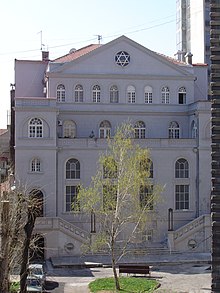Tourism in Serbia

The tourism in Serbia is a growing and increasingly important branch of economy of Serbia . In 2013 there were 2.2 million visitors in Serbia. Although Serbia has no access to the Adriatic or other seas , it is extremely diverse in terms of landscape, culture and history. Numerous fortresses , castles and sacred buildings , cities, villages and towns as well as natural landscapes and events are visited by travelers.
Tourism in Serbia is diverse and is divided into different areas, including rural , natural and ecotourism as well as gentle , slow and cultural tourism , but also the usual recreational and beach holidays as well as winter sports , cruises and boat tours , hunting - and fishing tourism , or special features such as bicycle , backpack and wine tourism , but also medical tourism .
The country has five national parks, 20 nature parks and around 590 nature reserves and nature reserves with a total area of 7,315.08 square kilometers, which means that more than 8 percent of the area of Serbia is under nature protection . In comparison, it is 3.6 percent in Germany. The landscape of these areas was primarily protected from development projects. One reason for this is that Serbia is 30 percent forested and most of it is natural. Furthermore, eight places in Serbia are listed in the Ramsar Convention for the Conservation of Wetlands.
The main tourist destinations in Serbia are primarily the capital Belgrade and the other large cities Novi Sad , Niš , Kragujevac and Subotica , but also smaller cities such as Jagodina , Užice , Požarevac and numerous health resorts , including Vrnjačka Banja and Sokobanja , or the Kopaonik and Zlatibor mountains as well as the Danube , which is traveled by cruise ships and boats.
Furthermore, Serbia offers numerous fortresses and monasteries as well as a multitude of lakes and gorges , of which the Iron Gate is the largest in Europe, as well as archaeological sites such as Mediana , Iustiniana Prima or the Lepenski Vir . Many of these geographical features are protected as UNESCO World Heritage .
introduction

Serbia and its people have always been between East and West, not only in a geographical sense, but also politically and culturally. First it was between the Byzantine and Roman Empires, and then between the Ottoman Empire and Western Christianity . Even in the time of Yugoslavia , the inhabitants of this region stood between the Warsaw Pact and the NATO countries. Due to the Yugoslav rejection of Stalinism and as a meeting place for the non-aligned states , the country with its capital Belgrade was an important political center during the Cold War .
The communist regime of the time was very open to tourist activities. During the Yugoslav wars (1991–1995) the number of foreign tourists fell, but Serbia continued to be visited because the country was largely spared from conflict with the exception of the Kosovo war in 1999. In addition, the fighting was limited to Kosovo , except for Operation Allied Force of NATO . The numbers have recovered since the end of the war and an increase in visitors was registered again.
There was also an enormous increase in the expansion of the tourist infrastructure and various travel guides were published abroad . Since then, rapid development has started. New hotels and tourist facilities were built in numerous cities and mountain regions . The number of Serbian tourists from home and abroad has been increasing steadily since then. The number of foreign tourists has increased again, especially in recent years.
facts and figures
In 2013, a total of 2,192,435 million tourists visited Serbia, of which 42 percent were foreign visitors. The number of visitors increased by 5.4 percent compared to 2012. An increase of 1.3 percent in overnight stays was also recorded, which totaled 6,567,460 million. The number of foreign tourists rose by 13.8 percent and amounted to 921,768 thousand with a total of 1,988,393 million overnight stays, which also increased by 10.7 percent compared to the previous year. 155,868 came from Bosnia and Herzegovina , 137,520 from Montenegro , 121,997 from Slovenia , 120,899 from Russia , 107,840 from Germany and over 100,000 tourists from Italy and Croatia .
The most visited travel destination compared to the previous year was Belgrade, followed by Novi Sad , the Zlatibor Mountains , the health resorts of Vrnjačka Banja and Sokobanja and the Kopaonik Mountains. In 2014, 240,782 tourists visited Serbia by the end of February. The number of visitors increased by 3 percent compared to the end of February of the previous year. 40 percent of these were foreign visitors, an increase of 15 percent compared to the previous year. Until then, the most visited destinations were still Belgrade and Novi Sad. Due to the continuous increase in tourists in Serbia over the years, it is estimated that a total of 2.5 to 2.8 million tourists will visit Serbia by the end of 2014, as well as the one million mark in foreign visitors for the first time since the collapse of socialist Yugoslavia is achieved again.
Medicinal baths and health resorts
In Serbia there are over 1000 cold and warm mineral springs and a great wealth of natural mineral gases and healing earth or mud. In over 53 thermal baths , some of which were already known to the Romans , spa treatments for a wide range of health problems and illnesses have been developed, which are supported by drinking medicinal waters or by medicinal baths . In addition to the bathrooms there are in Serbia and health resorts who because of their favorable climatic and geographical location spas were declared.
The baths of Serbia are mainly located in valleys or on hill slopes , surrounded by forests , meadows and orchards . The natural landscape of the baths is complemented by parks and hiking trails . Modern accommodations , sports fields and swimming pools complement the basic health facilities in the spas, but also facilities for various sports , massage parlors and fitness centers . In recent years, wellness programs have become particularly popular in Serbian health resorts. The bathrooms are also equipped for congresses and seminars as well as for sports teams. The surroundings of the thermal baths contain numerous cultural, historical and other attractions . A variety of events are also held there throughout the year. The most famous spas are Vrnjačka Banja , Sokobanja and Niška Banja .
Mountain tourism and winter sports
The majority of Serbia is dominated by mountains, from the Pannonian hills in the north to the borders of neighboring countries in the south. The mountains of Serbia belong to the Rhodope , Carpathian and Balkan Mountains as well as to the Dinaric mountain range . Zlatibor , Zlatar and Rajac are considered to be particularly rich in nature . Some mountains have been protected in five national parks or declared nature parks . Some have been declared climatic health resorts thanks to the extraordinary climate . The mountains are climbed both in summer and in winter. The exploration of karst caves and gorges as well as winter sports is possible in the mountains for tourists. The Kopaonik Mountains are particularly known for this. The accommodation options are also diverse, from four-star hotels to forest huts and youth hostels . Especially in summer, the Serbian mountains are a popular destination for Central European hikers for trekking in natural landscapes.
Serbian public parks
The Volksparks in Serbia were created to protect the typical architecture and the Serbian ethnic style. In contrast to the original Serbian villages, these are considered to be open-air museums that contain buildings of cultural and historical importance, but in which everyday life no longer takes place. These are reconstructed Serbian villages from the past two centuries, mainly built of wood and stone .
In the courtyards there are barns and other outbuildings that reflect the former village life. Some public parks also have wine cellars , horse paddocks and permanent museum exhibitions . The Drvengrad People's Park was built on one of the slopes of the Mokra Gora , a creation of the film director Emir Kusturica , in which there is a restaurant , a cinema and a gallery . Other ethno villages visited are Divljakovac and Beli Kamen . In the archaeologically oriented Volkspark in the village of Ravna , eight kilometers north of Knjaževac , near the Roman fortress Timacum Minus , there is a research facility in the village school .
Fortresses on the Danube
For a long time, the central part of Southeast Europe was the meeting point of different cultures, trade caravans and troops on campaigns . The remains of fortifications bear witness to these events and reflect the development of European military architecture from ancient times to the present. Because of the geographical location of the Danube Valley, the Roman , Serbian and Ottoman empires built a large number of fortifications along the river bank from the Batschka to the Iron Gate downstream . The best known are the fortress of Belgrade , the symbol of the city, the fortress Petrovaradin in Novi Sad , also known as the "Gibraltar of the Danube" and once the largest fortress in Europe in the 17th century, as well as the fortress Golubac , which is nicknamed the Pigeon City.
National and international events
Serbia, especially Belgrade, has hosted various major international events with a large number of foreign participants in the last few decades, which were associated with high security and organizational requirements. World famous events are the Exit , the Guča Trumpet Festival and the Vrnjačka Banja Carnival .
World cultural and documentary heritage and biosphere reserve
The list of world heritage includes over 1000 monuments of cultural and natural value from all over the world, which are recognized by UNESCO for their uniqueness, authenticity and integrity . In selecting the places Serbia had presented for inclusion in the World Heritage List, the focus was on Serbia's medieval heritage, in particular on monasteries of the Serbian Orthodox Church and its royal tombs with influences from Romanesque and Byzantine art as well recognizable Serbian features, also known as the Serbian-Byzantine style and architecturally shaped by the Raška , Macedonian and Morava schools .
The sites listed so far on the UNESCO World Heritage List include the Studenica Monastery , the medieval town of Stari Ras with the Sopoćani Monastery and St. Peter's Church , the archaeological excavation site Gamzigrad and the Galerius Palace as well as the medieval sacred buildings and monuments of Serbian culture in Kosovo , which includes the Visoki Dečani and Gračanica monasteries , as well as the Patriarchal Monastery of Peć and the Church of the Virgin of Ljeviša .
The archives of the inventor, physicist and electrical engineer Nikola Tesla, located in the Nikola Tesla Museum in Belgrade , and, since 2005, the Miroslav Gospel , a liturgical book made of parchment , which was created in the second half of the 12th century, belong to the world document heritage . It is one of the oldest surviving illustrated manuscripts in Cyrillic , which are characterized in style and iconography by a mixture of Italian and Byzantine influences. The Council of the UNESCO Biosphere Reserve has also declared the Golija Nature Park a biosphere reserve. Serbia is represented by its own ambassador to UNESCO.
Archaeological sites
Prehistoric and Ancient Heritage

The area of today's Serbia is rich in traces of ancient civilizations. In addition to archaeological sites that document human existence back into prehistory , there are numerous paleontological animal finds such as those of the mammoth , bison and giant deer , all of which date from the late Pleistocene . In 2009 the skeleton of a full-grown steppe mammoth was uncovered near Kostolac in the immediate vicinity of the Roman archaeological site of Viminatium, and in 2012 a mammoth cemetery with seven mammoth skeletons. The finds can be viewed in the Mammut Park, which opened there in 2014, is located 30 meters below ground and its architecture is unique in the world.
Archaeological evidence of human settlement in Serbia dates back to the Paleolithic around 40,000 BC. The finds in the country vary in their origin and type, including tools , weapons , metal vessels and shards of clay vessels . The oldest known European civilizations come from the Mesolithic and the late Neolithic and their traces were found in Serbia, for example in Lepenski Vir , which is shaped by the Starčevo culture , and the numerous sites around the Vinča culture , most recently the 7700 Year-old hoard from Belica , the most comprehensive treasure trove in Europe from the early Neolithic .
Roman heritage
The ancient cultural heritage on the territory of Serbia is great and especially the remains of the Roman Empire represent. 17, and thus a fifth of all Roman emperors come from today's Serbia . Among them Aurelian , Probus and Constantine the Great , who was born in Niš , who is one of the most important figures for Christian civilization, primarily because of the Constantinian turn he initiated , with which the rise of Christianity to the most important religion in the empire began. Large areas of Illyria , the provinces of Illyricum, upper Moesia and lower Pannonia roughly corresponded to today's Serbia. Beginning with the 3rd century, these areas developed into a central place of events for the Roman Empire.
Sun includes the coveted tourist street of Roman Emperor in Serbia ancient Roman cities , streets , ruins , artifacts and discoveries unterschiedlichster kind, including the archaeological site Gamzigrad in Zajecar , with the Galerius Palace on the list of World Heritage of UNESCO is recorded . So far, two boats of Roman origin have also been found in Serbian rivers. One of the largest military fortresses on the Danube was Viminacium near Požarevac .
The largest Roman bridge over the Danube, the almost one and a half kilometers long Trajan's Bridge , was built in the gorge of the Iron Gate. Near Sremska Mitrovica was Sirmium , the oldest Roman city on Serbian soil. Other important Roman cities in Serbia are Mediana near Niš, an important archaeological excavation site of the late Roman era, Iustiniana Prima near Leskovac and Singidunum , today's Belgrade, all of which are rich in Roman remains, but also in those of other cultures. Visiting these archaeological sites of these impressive legacies, which are steeped in history, is a highlight for those interested in culture and history.
Religious buildings and mausoleums


The monasteries, churches and royal tombs of Serbia, especially those of the Serbian Orthodox Church , are characteristic in their architecture and sculpture , their frescoes , icons , manuscripts and practical art . They are a magnet for visitors and tourists, as well as for experts from the Middle Ages . The monasteries are particularly characterized by their varied architecture and painting . Romanesque , Byzantine - and Serbian art created the Serbian-Byzantine style , a combination of three successive styles, those of the Raška , Macedonian and Morava schools .
The oldest church in Serbia and the only completely preserved monument from the time before the Nemanjids is St. Peter's Church , built in the 9th century . During the 12th and up to the 14th century, churches were built whose structural proportions , facade design and sculpture suggest Romanesque influences, including the monasteries Studenica , Banjska , Visoki Dečani , Gradac , Mileševa and Sopoćani . These monasteries are included in the Raška school . During the first half of the 14th century, structures such as the Gračanica Monastery were built .
Then a characteristic architectural style was formed in the area of the Morava Valley, the Morava School , which produced those colorful facades and buildings decorated with reliefs such as the monasteries of Ravanica , Lazarica , Ljubostinja and Kalenić . One of the most important Serbian Orthodox shrines is Hilandar , a Serbian monastery in the northern part of the so-called Holy Mountain , Mount Athos . This monastic republic consists of 20 main monasteries and is located on the Greek peninsula of Chalkidiki . This is where the Miroslav Gospel was written .
Other well-known and visited Orthodox churches are the Mala Remeta Monastery , one of the 16 monasteries in the Fruška Gora National Park , the Manasija , Poganovo , Žiča and Oplenac monasteries , on which the mausoleum of the Serbian royal dynasty Karađorđević is located. The Church of St. George the Great Martyr in Smederevo as well as St. Mark's Church and especially the Cathedral of St. Sava , also known as the Serbian Taj Mahal , the largest church in Southeast Europe and one of the largest Orthodox churches in the world.
The medieval monasteries are not only typical of the Serbian landscape, they are real art collections. The frescoes and icons of the churches form an important part of the country's cultural, historical and national wealth and heritage, including some of the UNESCO World Heritage Sites , including the Studenica and Sopoćani monasteries , St. Peter's Church and the Visoki Dečani and Kosovo monasteries Gračanica , the Patriarchal Monastery of Peć and the Church of the Virgin of Ljeviša . The Miroslav Gospel, on the other hand, is part of the UNESCO World Document Heritage.
In addition to the numerous Serbian Orthodox buildings, there are also other faiths, including those of the Roman Catholic Church , such as St. Mary's Church in Novi Sad, or those of Islam , including the Bajrakli and Altun-Alem mosques , as well as those of Judaism , like the synagogue of Belgrade , or other sacred buildings. These include the Kalmyk Buddhist Temple in Belgrade . The House of Flowers, on the other hand, is the mausoleum of the former President of Socialist Yugoslavia , Josip Broz Tito . Today it belongs to the complex of the Museum of the History of Yugoslavia and is visited by several 10,000 people every year.
National parks
Serbia has five national parks , the Đerdap , Fruška Gora , Kopaonik, Šar Planina and Tara national parks . Separate public companies were set up to manage them. The national parks belong to the European umbrella organization of national parks, biosphere reserves and nature parks Europarc . In the parks, the existing and valuable natural resources as well as the landscape and the geological and biological diversity are protected and serve scientific, educational, ideal, aesthetic, cultural and tourist purposes as well as health and recreation. They are operated according to the principles of environmental protection and sustainable development. Only those activities are permitted within the national parks that do not endanger the environment, that serve education, promote health, recreation, tourism and the traditional way of life of local communities and that do not threaten the existence of species, ecosystems or the environment.
traffic
Road safety has improved significantly with the passing of a relevant law that meets European standards. The enactment of a number of other laws that Serbia initiated in connection with the country's candidacy for membership of the European Union also contributed to this. The International Air Transport Association (IATA) has certified the Serbian national airline Air Serbia with AIOS (audit of international operational safety) and thus recognized the high safety standards as well as the quality of air traffic and technical maintenance of the airline .
The capital Belgrade is an important traffic junction of the European roads E70 and E75, the pan-European corridors 7 and 10, rail connections, the international airport "Nikola Tesla" and two international, navigable rivers.
See also
Individual evidence
- ↑ a b pks.rs: Mesečni Makroekonomski pregled br.2 - Podaci o turističkom prometu (Serbian) (English)
- ↑ a b c d 2,192,435 tourists have visited Serbia in 2013 (English) ( Memento of the original from August 16, 2014 in the Internet Archive ) Info: The archive link was inserted automatically and has not yet been checked. Please check the original and archive link according to the instructions and then remove this notice.
- ↑ a b c d Blic : Početkom 2014. broj turista u Srbiji povećan za tri odst (Serbian)
- ^ The Telegraph, June 28, 2012 Mammoth graveyard discovered in Serbia
- ↑ International Radio Serbia: Mammut Park opened in Viminacium
